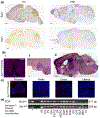The transcription factors SIX3 and VAX1 are required for suprachiasmatic nucleus circadian output and fertility in female mice
- PMID: 34212416
- PMCID: PMC8577618
- DOI: 10.1002/jnr.24864
The transcription factors SIX3 and VAX1 are required for suprachiasmatic nucleus circadian output and fertility in female mice
Abstract
The homeodomain transcription factors sine oculis homeobox 3 (Six3) and ventral anterior homeobox 1 (Vax1) are required for brain development. Their expression in specific brain areas is maintained in adulthood, where their functions are poorly understood. To identify the roles of Six3 and Vax1 in neurons, we conditionally deleted each gene using Synapsincre , a promoter targeting maturing neurons, and generated Six3syn and Vax1syn mice. Six3syn and Vax1syn females, but not males, had reduced fertility, due to impairment of the luteinizing hormone (LH) surge driving ovulation. In nocturnal rodents, the LH surge requires a precise timing signal from the brain's circadian pacemaker, the suprachiasmatic nucleus (SCN), near the time of activity onset. Indeed, both Six3syn and Vax1syn females had impaired rhythmic SCN output, which was associated with weakened Period 2 molecular clock function in both Six3syn and Vax1syn mice. These impairments were associated with a reduction of the SCN neuropeptide vasoactive intestinal peptide in Vax1syn mice and a modest weakening of SCN timekeeping function in both Six3syn and Vax1syn mice. Changes in SCN function were associated with mistimed peak PER2::LUC expression in the SCN and pituitary in both Six3syn and Vax1syn females. Interestingly, Six3syn ovaries presented reduced sensitivity to LH, causing reduced ovulation during superovulation. In conclusion, we have identified novel roles of the homeodomain transcription factors SIX3 and VAX1 in neurons, where they are required for proper molecular circadian clock function, SCN rhythmic output, and female fertility.
Keywords: PER2::luciferase; circadian; conditional knock-out; luteinizing hormone surge; six homeobox 3; ventral anterior homeobox 1.
© 2021 Wiley Periodicals, LLC.
Conflict of interest statement
CONFLICT OF INTEREST
The authors declare no conflict of interest.
Figures







Similar articles
-
The transcription factor VAX1 in VIP neurons of the suprachiasmatic nucleus impacts circadian rhythm generation, depressive-like behavior, and the reproductive axis in a sex-specific manner in mice.Front Endocrinol (Lausanne). 2023 Dec 22;14:1269672. doi: 10.3389/fendo.2023.1269672. eCollection 2023. Front Endocrinol (Lausanne). 2023. PMID: 38205198 Free PMC article.
-
The Homeodomain Transcription Factors Vax1 and Six6 Are Required for SCN Development and Function.Mol Neurobiol. 2020 Feb;57(2):1217-1232. doi: 10.1007/s12035-019-01781-9. Epub 2019 Nov 9. Mol Neurobiol. 2020. PMID: 31705443 Free PMC article.
-
Deletion of Six3 in post-proliferative neurons produces weakened SCN circadian output, improved metabolic function, and dwarfism in male mice.Mol Metab. 2022 Mar;57:101431. doi: 10.1016/j.molmet.2021.101431. Epub 2021 Dec 31. Mol Metab. 2022. PMID: 34974160 Free PMC article.
-
Haploinsufficiency of Homeodomain Proteins Six3, Vax1, and Otx2 Causes Subfertility in Mice via Distinct Mechanisms.Neuroendocrinology. 2019;109(3):200-207. doi: 10.1159/000494086. Epub 2018 Sep 27. Neuroendocrinology. 2019. PMID: 30261489 Free PMC article. Review.
-
SIX3 function in cancer: progression and comprehensive analysis.Cancer Gene Ther. 2022 Nov;29(11):1542-1549. doi: 10.1038/s41417-022-00488-9. Epub 2022 Jun 28. Cancer Gene Ther. 2022. PMID: 35764712 Review.
Cited by
-
Role of circadian clock in female embryo implantation.Front Cell Dev Biol. 2025 Jun 4;13:1607491. doi: 10.3389/fcell.2025.1607491. eCollection 2025. Front Cell Dev Biol. 2025. PMID: 40535570 Free PMC article. Review.
-
Placental circadian lincRNAs and spontaneous preterm birth.Front Genet. 2023 Jan 11;13:1051396. doi: 10.3389/fgene.2022.1051396. eCollection 2022. Front Genet. 2023. PMID: 36712876 Free PMC article.
-
Identification of Novel Genetic Loci Involved in Testis Traits of the Jiangxi Local Breed Based on GWAS Analyses.Genes (Basel). 2025 May 27;16(6):637. doi: 10.3390/genes16060637. Genes (Basel). 2025. PMID: 40565529 Free PMC article.
-
Low CLOCK and CRY2 in 2nd trimester human maternal blood and risk of preterm birth: a nested case-control study†.Biol Reprod. 2021 Oct 11;105(4):827-836. doi: 10.1093/biolre/ioab119. Biol Reprod. 2021. PMID: 34142702 Free PMC article.
-
Co-alterations of circadian clock gene transcripts in human placenta in preeclampsia.Sci Rep. 2022 Oct 25;12(1):17856. doi: 10.1038/s41598-022-22507-3. Sci Rep. 2022. PMID: 36284122 Free PMC article.
References
-
- Alvarez JD, Hansen A, Ord T, Bebas P, Chappell PE, Giebultowicz JM, Williams C, Moss S, & Sehgal A (2008). The circadian clock protein BMAL1 is necessary for fertility and proper testosterone production in mice. Journal of Biological Rhythms, 23(1), 26–36. 10.1177/0748730407311254 - DOI - PMC - PubMed
MeSH terms
Substances
Grants and funding
- R01 HD100580/HD/NICHD NIH HHS/United States
- R00 HD084759/HD/NICHD NIH HHS/United States
- T32 HD087166/HD/NICHD NIH HHS/United States
- P42 ES010337/ES/NIEHS NIH HHS/United States
- P30 DK063491/DK/NIDDK NIH HHS/United States
- P50 HD028934/HD/NICHD NIH HHS/United States
- P30 CA023100/CA/NCI NIH HHS/United States
- R01 DK044838/DK/NIDDK NIH HHS/United States
- R01 HD072754/HD/NICHD NIH HHS/United States
- R01 HD082567/HD/NICHD NIH HHS/United States
- T32 HD007203/HD/NICHD NIH HHS/United States
- P30 NS047101/NS/NINDS NIH HHS/United States
- I01 BX001146/BX/BLRD VA/United States
- K99 HD084759/HD/NICHD NIH HHS/United States
- F32 HD090837/HD/NICHD NIH HHS/United States
- P50 HD012303/HD/NICHD NIH HHS/United States
- R24 HD102061/HD/NICHD NIH HHS/United States
LinkOut - more resources
Full Text Sources
Molecular Biology Databases
Research Materials
Miscellaneous

